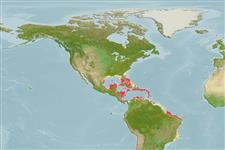Common names from other countries
Environment: milieu / climate zone / depth range / distribution range
Ecología
Asociado a arrecife; salobre; rango de profundidad 0 - 69 m (Ref. 415). Tropical
Western Atlantic.
Length at first maturity / Tamaño / Peso / Age
Maturity: Lm ? range ? - ? cm Max length : 250 cm WD macho / no sexado; (Ref. 99323)
Barrel shaped, with thick walls. Purple to red brown externally, tan internally. Surface with protuberances with round or blade-like outlines. Brittle and crumbly in consistency. Oscules on the inner side of vase; 0.2 - 0.3 cm (Ref. 415).
Maximum depth reported taken from Ref. 128739.. Maximum length refers to base diameter (Ref. 99323). Common on reef environments (Ref. 415). Also found in mangroves (Ref. 86836). Inhabits shallow coral reefs, coral communities, coralline algae reefs, algal nodules, and mesophotic reefs (Ref. 128739).
Life cycle and mating behavior
Madurez | Reproducción | Puesta | Huevos | Fecundidad | Larva
Broadcast spawner.
Collin, R., M.C. Díaz, J. Norenburg, R.M. Rocha, J.A. Sánchez, M. Schulze, A. Schwartz and A. Valdés. 2005. (Ref. 415)
IUCN Red List Status (Ref. 130435)
CITES status (Ref. 108899)
Not Evaluated
Not Evaluated
Human uses
| FishSource |
Herramientas
Fuentes de Internet
Estimates based on models
Preferred temperature
(Ref.
115969): 26.4 - 28.2, mean 27.5 (based on 519 cells).
Resiliencia
Muy bajo, población duplicada en un tiempo mínimo superior a 14 años (K=0.04).
Price category
Unknown.
